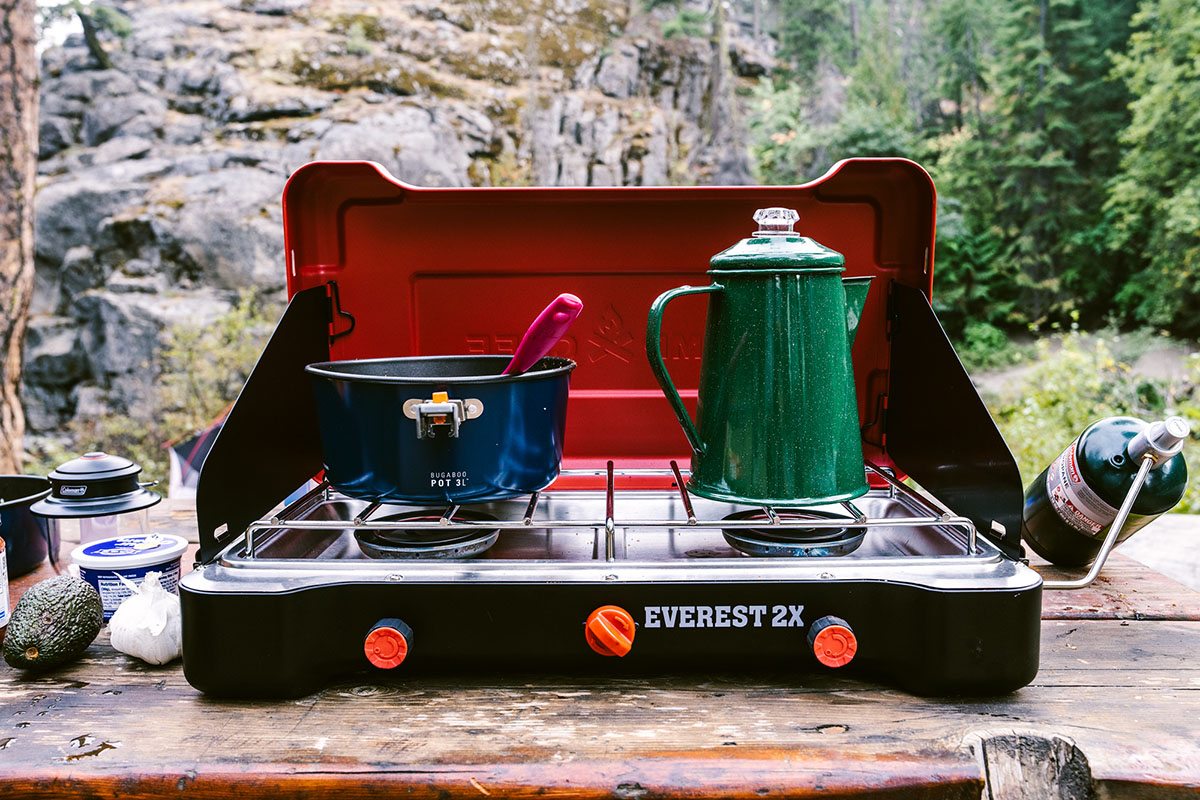
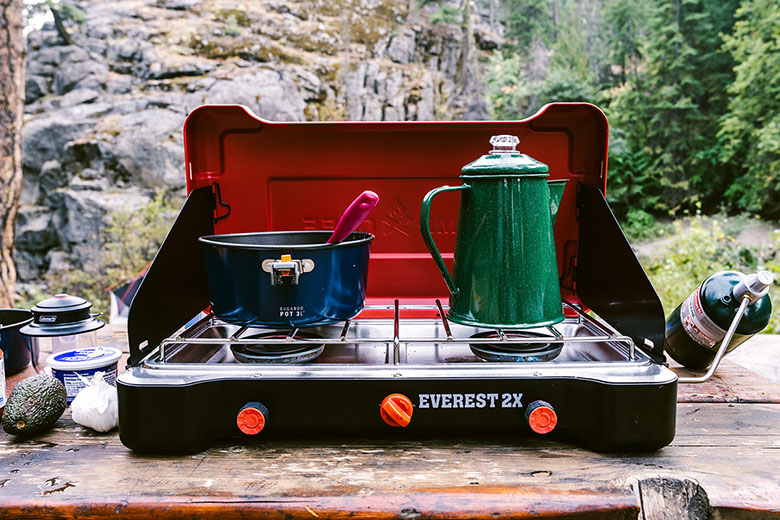
If you think camping in the great outdoors means sacrificing a proper home-cooked meal, think again. Today's camping stoves can bring a whole new level of gourmet to your car camping and basecamping adventures. With a modern, quality design, you can expect consistent fuel output, strong flames, and superior simmer control. Camping stove sizes vary from small tabletop models to freestanding behemoths for large groups or outdoor kitchens, and below you'll find our favorite models for 2025. For first-timers or those desiring some background information, it’s worth checking out our comparison table and buying advice while narrowing down your search, as well as information on how we approach our testing process. If you're looking for lighter and smaller options for backpacking, check out our article on the best backpacking stoves.
Editor's note: We updated this guide on April 16, 2025, to add new information and images from continued testing and ensure that all product recommendations, prices, and specs were current at the time of publishing.
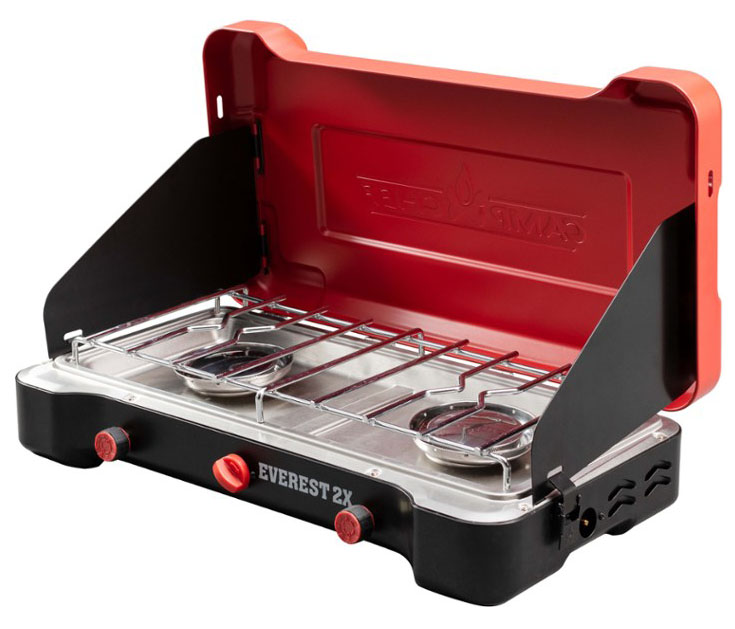 Category: Tabletop
Category: Tabletop
Fuel: Propane
Burners: 2 @ 20,000 BTUs
Weight: 12 lb. 0 oz.
Dimensions: 25.2 x 12.7 x 5.6 in.
What we like: Quality build and excellent all-around performance.
What we don’t: Expensive and a little heavy and bulky.
Camp Chef’s Everest is one of the most popular and proven designs in the world of camping stoves, offering a hard-to-beat combination of cooking power, convenience, and superior reliability. In terms of output, you get two large burners that pump out plenty of heat (20,000 BTUs each) but also have excellent simmer control for cooking more diverse and intricate meals. And with the update to the “2X” model, Camp Chef gave the design a nice upgrade with locking metal latches at each side, a more protective windscreen, a slightly larger cooking space, and a beefed-up build that’s also more modern. Combined with a reasonable 12-pound weight and integrated handle, the Everest 2X is hard to beat.
The biggest knock against the Camp Chef Everest 2X is its $190 price tag, though it's often available for less on Amazon. And those who get out a lot and like to cook intricate, diverse meals may find the investment worth it, though the 20,000-BTU burners are likely overkill for most folks. In our experience, quality 10,000-BTU burners provide plenty of power for the majority of meals and often come at a much more palatable price point. In addition, the 2X model is a little larger and bulkier than the prior generation, although it’s still reasonably compact and easy to haul around; you just may have to play a bit of Tetris in smaller vehicles. But at the end of the day, there’s no denying the high-quality build and impressive cooking performance, making the Everest 2X a competitive option for discerning camp chefs.
Read more: Camp Chef Everest 2X review
See the Camp Chef Everest 2X

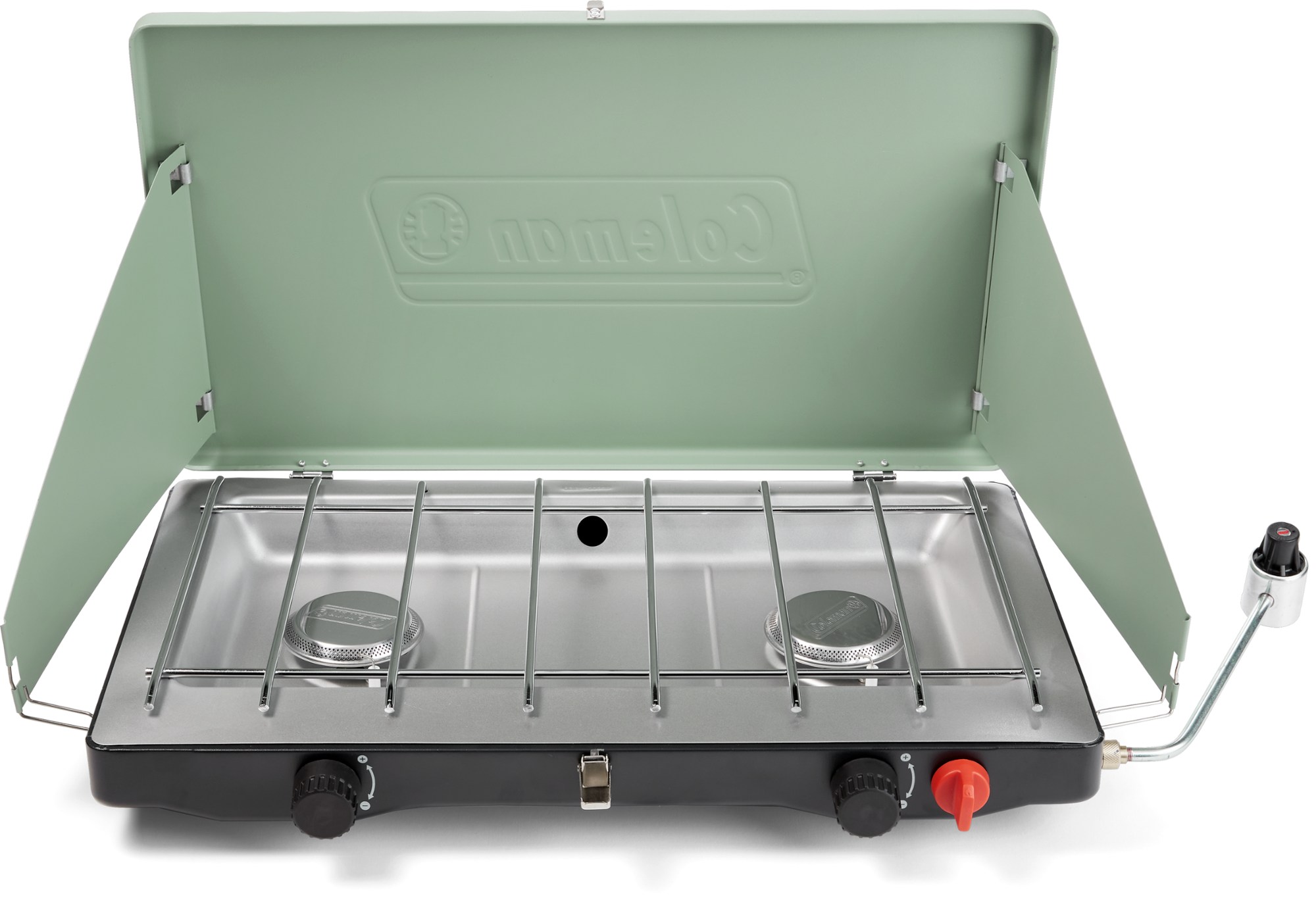 Category: Tabletop
Category: Tabletop
Fuel: Propane
Burners: 2 @ 10,000 BTUs
Weight: 11 lb. 14.4 oz.
Dimensions: 21 x 13 x 3.6 in.
What we like: Reliable performance and nicely appointed for the price.
What we don’t: Less refined than pricier designs.
For years, campers have turned to Coleman stoves for simple, reliable performance. Toward the lower end of their camping stove lineup is the Cascade Classic, which lacks the refinement and all-out durability of pricier designs but is nevertheless a solid value for what you get. For a considerable $90 less than the top-ranked Everest 2X, the Cascade offers adequate power with two 10,000-BTU burners, includes matchless push-button ignition to keep your hands safe during start-up (fairly uncommon among budget designs), and boasts sizable windscreens to keep the flame protected in gusty weather. Added up, it’s a very well-rounded option for occasional campers and those who don’t need the top-end performance and power of more premium designs.
The Cascade Classic is our favorite entry-level camping stove, but budget seekers might also consider Coleman’s own Triton (listed below) or their tried-and-true Classic Propane. The Triton is a little more powerful with two 11,000-BTU burners and has a larger cooking space. However, the lack of auto-ignition is a notable downside and the main reason we give the edge to the Cascade Classic. Alternatively, the longstanding Classic Propane retails for just under $83 (though it's out of stock at the time of publishing) and matches the Cascade in power, but it, too, lacks matchless ignition. The $100 Cascade certainly isn’t perfect—it’s been plagued by reports of a faulty ignition out of the box (bring a lighter with you!), and simmer control is a sizable step down from high-end designs like the Camp Chef Everest 2X above. But for low-maintenance campers in need of a simple and affordable stove, it checks all the right boxes.
See the Coleman Cascade Classic

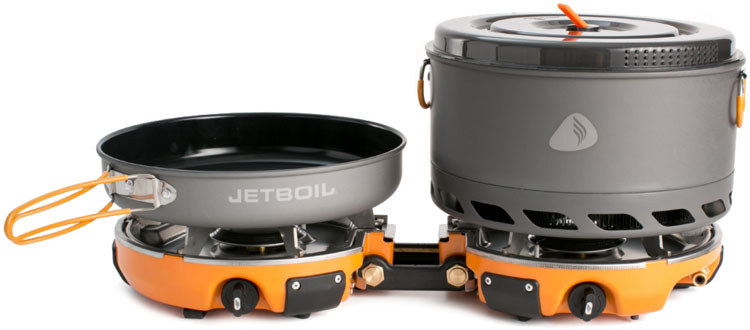 Category: Tabletop
Category: Tabletop
Fuel: Propane
Burners: 2 @ 10,000 BTUs
Weight: 9 lb. 5.0 oz.
Dimensions: 10.3 x 7.2 in.
What we like: An entire cook system that's under 10 pounds and very compact.
What we don’t: The priciest design on our list; plastic windshield is not our favorite.
Jetboil is best known for their lightweight backpacking stove systems, but they made a serious foray into the camping world with the Genesis. The concept is the first of its kind: an all-in-one camping system that comprises two burners plus a 5-liter pot and 10-inch ceramic pan. Jetboil designed the system to nest neatly together for compact storage: The stove itself folds in half and fits inside the pot with the pan as a lid, and this all nests inside a nice carrying bag. The total weight (other than a 16 oz. propane bottle) is less than 10 pounds, which is lighter than almost all the standalone stoves on this list. Additionally, simmer control and burner output are excellent, and because the burners were specifically created to pair with the included pot and pan, there’s less fuel waste.
Despite the high praise, the system’s $400 MSRP is borderline astronomical, especially compared to an option like the Everest 2X above. For under half the cost, the Everest offers double the burner power and is only about 2 and a half pounds heavier (that is without cookware, though). Alternatively, campers who already have cookware can save $100 with the standard Genesis, which is identical to the version here minus the pot and pan. Jetboil also makes the $220 HalfGen, which is a single burner and 9-inch fry pan, but this is less versatile overall (though it does have appeal for tailgating and solo travelers). Overall, if you can get past the steep price point, the Genesis Basecamp System is an innovative and well-executed all-in-one design with a lot of positive reviews to its name.
See the Jetboil Genesis Basecamp System

 Category: Tabletop
Category: Tabletop
Fuel: Butane
Burners: 1 @ 7,650 BTUs
Weight: 5 lb. 0.8 oz.
Dimensions: 14 x 12.2 x 4.7 in.
What we like: Compact, easy to clean, and very affordable
What we don’t: Single burner is limiting and butane fuel doesn’t work well in the cold.
Let’s start with the obvious: This Coleman stove isn’t for serious camp chefs or large-group cookouts. But the 1-Burner Butane is a very affordable single burner that performs well for limited use, as a backup, or as a cheap way to add a third burner for large groups. The stovetop easily accommodates a kettle or pan (up to 10 in.) and performs admirably considering its small size. We've even had great luck using a large wok on this burner since there are no sidewalls to be constricted by. We also love the slightly inset design that adds crucial protection against wind (since there's no windscreen) and the included carrying case. All in all, this is a great choice for bringing along if your primary cooking will be done over a fire pit but you need a burner for quick efforts like heating water.
As its name suggests, the Classic 1-Burner runs on butane, which isn’t as readily available as the ubiquitous green propane canisters. In addition, butane struggles in cold temperatures (around and below freezing), so it’s less versatile than the propane designs on our list and also falls short of more winter-ready liquid-fuel models. While there are some obvious downsides to a burner like this, it's still a well-rounded choice for a butane model, and the sub-$40 price makes it readily accessible for a lot of folks. Other leading one-burner options to consider include Snow Peak's compact Home & Camp Burner and Coleman’s propane-powered Cascade 18, although both designs are significantly pricier.
See the Coleman Classic 1-Burner Butane Stove
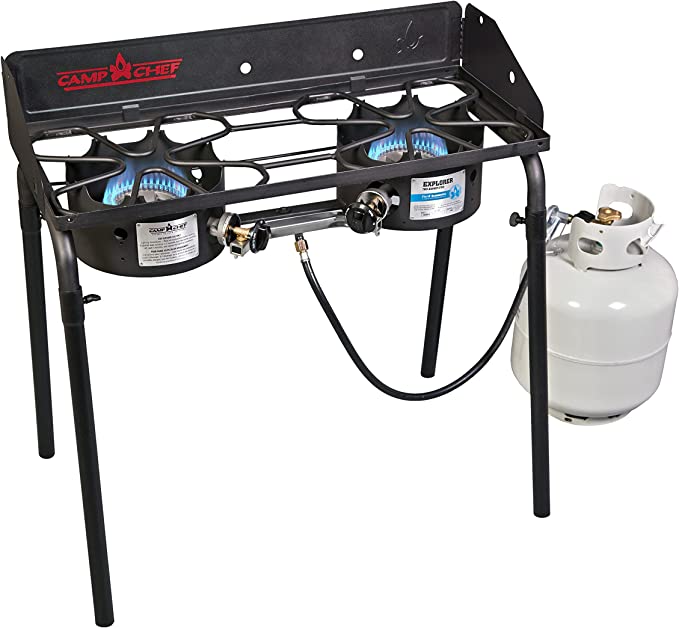 Category: Freestanding or tabletop
Category: Freestanding or tabletop
Fuel: Propane
Burners: 2 @ 30,000 BTUs
Weight: 30 lb. 8.0 oz.
Dimensions: 32 x 14 in. (cooking area), 29 in. high
What we like: Great value for the output.
What we don’t: Bulky and pretty barebones on features.
In terms of burner performance, you'll be hard-pressed to find more quality output for your dollar than the Camp Chef Explorer. The 60,000 total BTUs from the two burners are a great pairing for large-group camp cookouts or even emergency use at home. The stove also sets up quickly, and its sturdy legs are individually adjustable to adapt to uneven ground. In keeping the price down, however, the Explorer is sparse on features: There is no push-button ignition, and the burners are less protected from wind than more premium offerings.
The upside of the simplistic design is that the Explorer is ripe for various accessories from Camp Chef, including a barbecue box, griddle, or pizza oven. Large dials are easy to use and function in the same way as your cooktop at home, but unfortunately, that also means a hefty weight: The powder-coated assembly tips the scales at 30 pounds 8 ounces. Leaving behind the legs will trim some of that weight (and allow you to use the burners on a tabletop or tailgate), but the Explorer remains overkill for less serious campers. Bigger groups should also check out the $260 three-burner version of the Explorer, which adds an additional 30,000 BTUs of output. And for a more fully featured two-burner alternative from Camp Chef, check out their popular (but much pricier) Pro 60X (now renamed on Camp Chef's site to the Pro 14), which includes fold-out side tables for easy prep.
See the Camp Chef Explorer 14
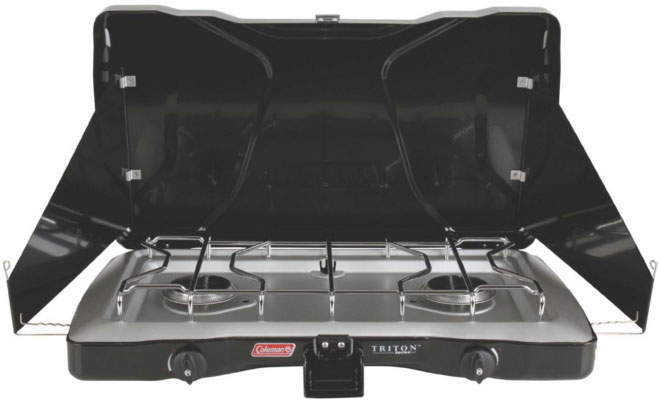 Category: Tabletop
Category: Tabletop
Fuel: Propane
Burners: 2 @ 11,000 BTUs
Weight: 10 lb. 8.8 oz.
Dimensions: 23 x 13.75 x 5.75 in.
What we like: More powerful than the Cascade Classic above for the same price.
What we don’t: No auto ignition and less flame precision than pricier units.
Joining the Cascade Classic above is another well-rounded budget design from Coleman: their Triton Camping Stove. The tabletop design features two strong, highly adjustable 11,000 BTU burners that run on a standard 16-ounce propane canister (adapters are available to make it compatible with a larger tank, which is true for almost all the stoves here). With decent simmer control and solid output at full tilt, the Coleman is one of only a few stoves in its price range that’s capable enough for cooking diverse meals. Last but not least, its 10-pound-8.8-ounce weight and manageable size make the Triton easy to transport in a car and store at home.
What are the downsides to the Coleman Triton? True camp chefs may want to upgrade to a more refined unit that delivers better precision, like the Camp Chef Everest 2X above. Further, cooking space is a little on the small side compared with premium tabletop models (the Everest 2X is 2.2 in. wider). That said, the Triton is roomy enough for most meals and can accommodate two 10-inch pans side by side. Finally, however, you miss out on auto-ignition in this model—there is a piezo-equipped version available for $121, or you can opt for the $100 Cascade Classic above. These nitpicks aside, the Triton still offers impressive cooking power and reliability at a very competitive price, earning it a respectable finish on our list.
See the Coleman Triton Camping Stove
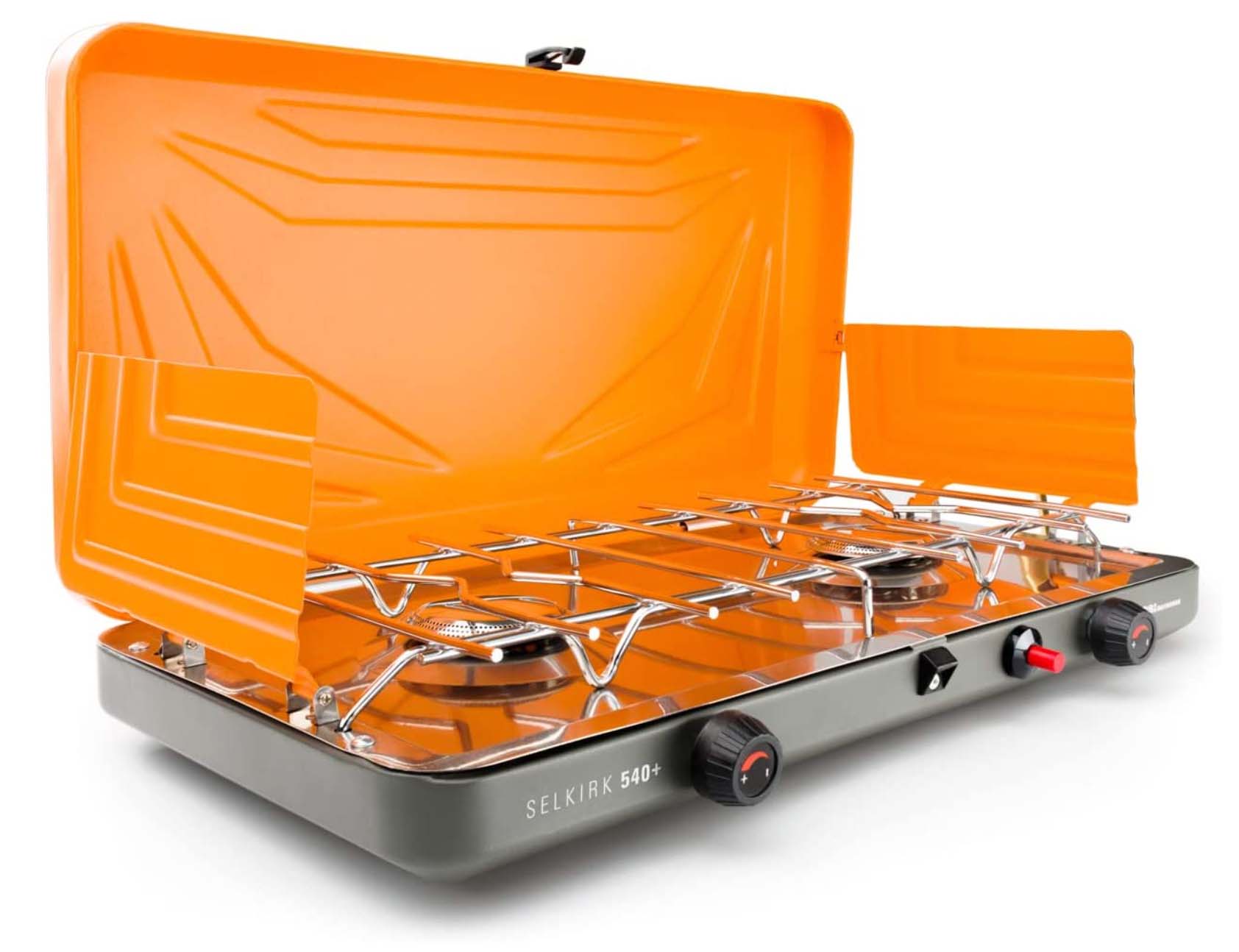 Category: Tabletop
Category: Tabletop
Fuel: Propane
Burners: 2 @ 14,000 BTUs
Weight: 10 lb. 0 oz.
Dimensions: 21.4 in x 12.9 in x 3.8 in.
What we like: Good all-around performance and more BTUs than most of the competition.
What we don’t: Still not a standout in cooking space or build quality.
Camping specialist GSI released the Selkirk 540 a few years back as a competitor to two-burner designs like the Camp Chef Everest, and the latest 540+ is more competitive than ever. The biggest change was the substantial boost in power: While the original model was pretty average with two 10,000-BTU burners, the latest 540+ ups the ante with 14,000 BTUs of output per burner, beating out alternatives like the Jetboil Genesis (10,000 BTUs), Coleman Triton (11,000 BTUs), and many others here. Despite the upgrade, the Selkirk 540+ is still relatively affordable at $150 (just $10 more than the past-generation model) and includes handy features like push-button ignition, micro control valves to tweak the flame, and plenty of space to accommodate two larger pots or pans side by side. Plus, GSI nailed the details with a built-in and easy-to-grab carry handle, a powder-coated exterior, and generous windscreens to block light gusts.
Where does the Selkirk 540+ fall short of its competitors? The first knock is cooking space, which is a couple inches smaller than what you get with the Everest 2X (21.4 in. vs. 25.2 in.). The Jetboil Genesis can also be connected to other Jetboil stoves to increase efficiency and speed when cooking more intricate meals. Finally, some users have reported issues with the igniter (though this tends to be true across all brands) and general build quality. That said, no stove is perfect, and the Selkirk is reasonably dependable and well considered for the price. Of note: GSI also sells the stove in a 460+ model for $120, which also features two 14,000-BTU burners but in a smaller, more compact design that sacrifices some cooking space.
See the GSI Outdoors Selkirk 540+
 Category: Tabletop
Category: Tabletop
Fuel: Propane
Burners: 2 @ 10,200 BTUs
Weight: 8 lb. 2.5 oz.
Dimensions: 18.7 x 11.6 x 3.1 in.
What we like: Sleek, relatively lightweight, and excellent craftsmanship.
What we don’t: No auto-ignition or side windscreens, smaller burners, and pricey.
If you're someone who loves finding the sleekest, most well-thought-out design, the Primus Kinjia is not to be missed. Primus is a Swedish company founded over 130 years ago, and they were the first to create a soot-free kerosene stove. Needless to say, their commitment to the craft is clear: The Kinjia is a beautiful stove. Slim, with die-cast aluminum and a wood-trimmed handle, this is the only stove in our lineup other than the GSI Pinnacle Pro below to offer a flexible fuel hose, which provides many more options for where you can place your fuel bottle.
The Kinjia has a respectable 10,200-BTU-per-burner output, but the diameter of those burners is noticeably smaller than many other options here. This stove is also one of the priciest designs in our round-up at $230 (though it's available for $210 through REI at the time of publishing). But the cost may be worth it if you're a sucker for impeccable design, and as long as you're not cooking huge meals in giant cookware, the burner size shouldn't be an issue—precise burner control means more delicate cooking like simmering is top-notch. The Kinjia also doesn't have side windscreens, nor an auto-ignition, but if you appreciate simple things done well, this stove offers a great cooking experience, is lightweight, and has an undeniable Swedish appeal.
See the Primus Kinjia
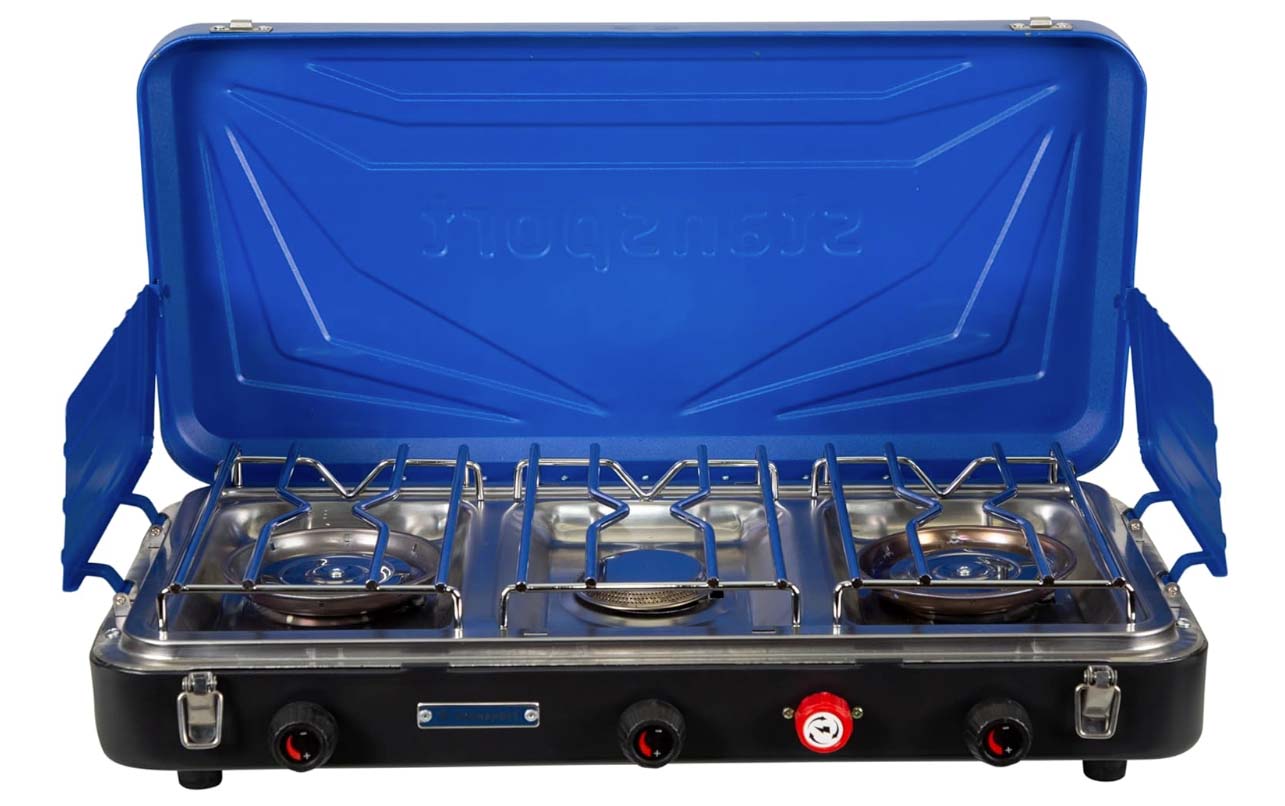 Category: Tabletop
Category: Tabletop
Fuel: Propane
Burners: 2 @ 25,000 BTUs; 1 @ 10,000 BTUs
Weight: 13 lb. 5.0 oz.
Dimensions: 23 x 12.75 x 4.3 in.
What we like: Three powerful burners at a great price.
What we don’t: Burners are close together, which limits which cookware you can use.
Two burners are sufficient for most campers, but aspiring camp chefs or those who typically head out with larger groups might want to step up to a three-burner stove. Stansport’s 3-Burner Propane Stove stands out as one of only a few tabletop 3-burner designs on the market, which makes it far easier to transport and less cumbersome to set up than a freestanding design like the Explorer above. The stove is reasonably sized and perfectly manageable for one person to carry from car to campsite, though it's a bit heftier than most two-burner models. Importantly, it also comes equipped with helpful touches like matchless ignition, intuitive temperature controls, and an integrated windscreen—all at a very palatable $160 full MSRP (and well under $100 on Amazon almost always).
However, the Stansport 3-Burner isn’t without limitations. First, while output is quite impressive at 60,000 total BTUs, it’s important to note that the center burner is noticeably less powerful than the side burners (10,000 BTUs vs. 25,000 BTUs). If you anticipate utilizing all three burners, it may require some advance planning to time things properly. The burners are also situated very close to each other in order to keep things compact, which limits the amount of space for larger pots and pans. Finally, the Stansport is a step down in overall quality and ruggedness compared to an option like the Camp Chef Everest above, although the fact that you get a third burner for less money is certainly enticing. For a bump in cooking space, Coleman’s Cascade 328 3-Burner is an inch wider and 4.6 inches longer but much pricier at $220 and lacking in output compared to the Stansport with just 28,000 total BTUs. A final option to consider is Camp Chef’s three-burner Tahoe, although its freestanding build is much heavier, bulkier, and more expensive than tabletop designs.
See the Stansport 3-Burner Propane Stove
 Category: Tabletop
Category: Tabletop
Fuel: Propane
Burners: 2 @ 11,000 BTUs
Weight: 11 lb. 0 oz.
Dimensions: 20 in x 12.4 in x 1.4 in
What we like: Super sleek and streamlined; price came down $50 with version 2.
What we don’t: Less robust and portable than the competition; no spot to store the regulator.
For those limited on space in their vehicle or gear storage, GSI Outdoors offers a unique solution in their sleek and modern Pinnacle Pro 2. At just 1.4 inches tall when closed, the Pinnacle Pro is significantly thinner than most two-burner alternatives, even including the compact Kinjia above (3.1 in.). That said, you still get respectable output with two 11,000-BTU burners, as well as premium features like a three-sided windscreen, dual push-button igniters, and a coated, non-stick drip pan that makes cleanup quick and easy. Additionally, we found the deployable legs helpful for raising the stove to a convenient height when cooking on a camping table.
Why do we have the GSI Pinnacle Pro ranked lower in our lineup? Trimming weight and bulk almost always translates to a drop in durability, and the Pinnacle Pro is noticeably less confidence-inspiring and robust than alternatives like the Everest 2X and Selkirk 540+ above. Further, the windscreens at the sides are short and not all that protective, the stove lacks a carry handle for transport, and there’s no spot to secure or stow the fuel adapter when not in use. GSI does sell a padded storage case that will house both the stove and adapter, but it’ll run you an additional $40. Whether or not the minimalist design is worth the higher price of this stove is up to you (though the most current version is $50 cheaper than the last), but we prefer the easier-to-trust constructions of the two-burner models above (most of which are also cheaper).
See the GSI Outdoors Pinnacle Pro 2
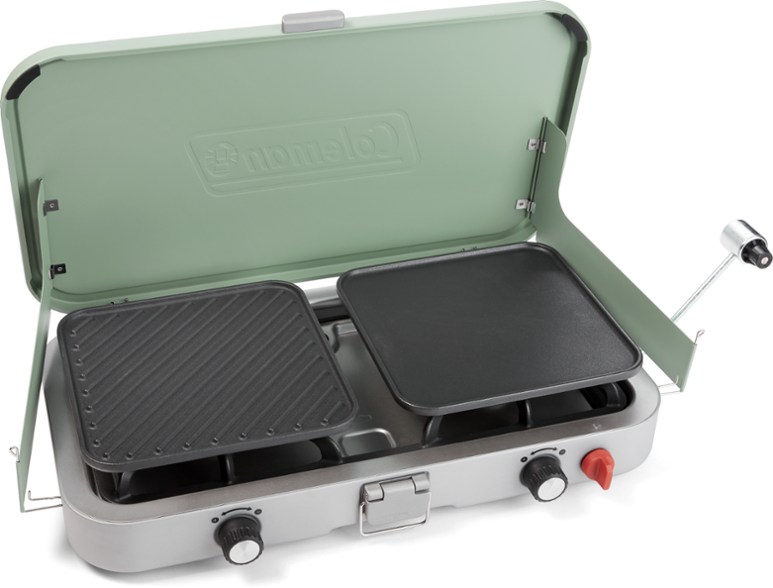 Category: Tabletop
Category: Tabletop
Fuel: Propane
Burners: 2 @ 12,000 BTUs
Weight: 14 lb. 12.8 oz.
Dimensions: 22 x 13.2 x 3.7 in.
What we like: Functional 3-in-1 design and good output.
What we don’t: Pricier but less premium than the Camp Chef Everest above.
We loved Camp Chef's Rainier 2X for a stove and grill combo, but it doesn't seem to be available anymore and the grill portion took up most of the cooking space, limiting the types of meals you could make. Enter Coleman’s Cascade 3-in-1, which addresses our main complaint about the Rainier (lack of versatility) with swappable grill and griddle accessory tops. The concept is simple but effective: If you need to use a burner or two, simply leave off the add-ons; if you’re whipping up breakfast or burgers, place one (or both) of the cast-iron plates over a burner and fire it up. The Cascade is on the pricier end at $230 and relatively heavy at nearly 15 pounds all in, but the 3-in-1 functionality does help justify the cost and heft.
In addition to being versatile, the Coleman Cascade also boasts two powerful 12,000-BTU burners. But the devil is in the details: Some users report food easily sticking to the accessory tops due to the lower-quality cast iron (be sure to treat them ahead of time for the best results), and the windscreens at the sides are very short and will do very little to combat strong gusts. Finally, you’ll need to find a flat surface for the stove when using the accessory tops to prevent grease and other juices from dripping onto the ground (and potentially also your clothes and shoes). But if you can deal with these drawbacks and plan to use both the burners and add-ons regularly, the Cascade is a well-executed and versatile option.
See the Coleman Cascade 3-in-1
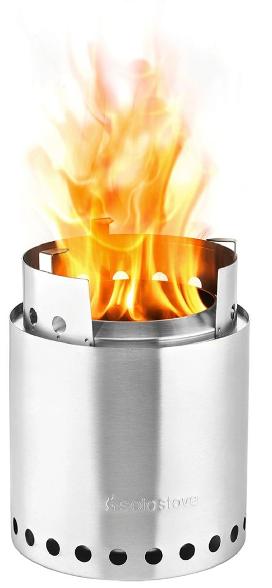 Category: Freestanding
Category: Freestanding
Fuel: Wood
Burners: 1
Weight: 2 lb. 3.2 oz.
Dimensions: 9.25 x 7 in.
What we like: A light and portable wood-burning stove that doubles as a mini fire pit.
What we don’t: Not as versatile as many of the picks above.
Solo Stove is known for their thoughtfully built portable fire pits, and their Campfire Stove is arguably the most well rounded of the bunch. Unlike other designs here, the Campfire runs off wood rather than gas, eliminating the need to purchase and pack fuel canisters on trips. How it works: Intake holes along the bottom of the chamber channel air up and through smaller openings at the top, minimizing smoke and allowing the fire to burn hot and evenly. And when it comes time to cook, an inset ring at the top of the stove concentrates heat at the center of your pot or pan while also providing protection against the wind.
The Campfire is a unique but functional option for cooking easy meals in certain areas, but there are some inherent downsides to the wood-burning design. First and foremost, we recommend researching ahead of time to check on terrain, conditions, and regulations—you’ll want to make sure you have plenty of dry wood and that there are no fire bans in place. And from a performance standpoint, you get far less precision and finesse compared to a standard two-burner propane model, and output can vary depending on the type and quality of wood you use, the construction of your fire, outside factors like wind, and more. That said, we love the two-for-one nature of the Campfire—it’s both a stove and a small fire pit in one—and see a lot of appeal for use at home too, whether you’re hosting a backyard gathering or just want to roast some marshmallows with the kids.
See the Solo Stove Campfire Stove
| Stove | Price | Category | Fuel | Burners | Weight | Ignition |
|---|---|---|---|---|---|---|
| Camp Chef Everest 2X | $190 | Tabletop | Propane | 2 @ 20,000 BTUs | 12 lb. 0 oz. | Matchless |
| Coleman Cascade Classic | $100 | Tabletop | Propane | 2 @ 10,000 BTUs | 11 lb. 14.4 oz. | Matchless |
| Jetboil Genesis Basecamp | $400 | Tabletop | Propane | 2 @ 10,000 BTUs | 9 lb. 5.0 oz. | Matchless |
| Coleman Classic 1-Burner | $39 | Tabletop | Butane | 1 @ 7,650 BTUs | 5 lb. 0.8 oz. | Matchless |
| Camp Chef Explorer 14 | $150 | Freestanding | Propane | 2 @ 30,000 BTUs | 30 lb. 8.0 oz. | Manual |
| Coleman Triton | $100 | Tabletop | Propane | 2 @ 11,000 BTUs | 10 lb. 8.8 oz. | Manual |
| GSI Selkirk 540+ | $150 | Tabletop | Propane | 2 @ 14,000 BTUs | 10 lb. 0 oz. | Matchless |
| Primus Kinjia | $230 | Tabletop | Propane | 2 @ 10,200 BTUs | 8 lb. 2.5 oz. | Manual |
| Stansport 3-Burner Stove | $160 | Tabletop | Propane | 2 @ 25k, 1 @ 10k BTUs | 13 lb. 5.0 oz. | Matchless |
| GSI Pinnacle Pro 2 | $200 | Tabletop | Propane | 2 @ 11,000 BTUs | 11 lb. 0 oz. | Matchless |
| Coleman Cascade 3-in-1 | $230 | Tabletop | Propane | 2 @ 12,000 BTUs | 14 lb. 12.8 oz. | Matchless |
| Solo Stove Campfire | $110 | Freestanding | Wood | 1 (no BTU rating) | 2 lb. 3.2 oz. | Manual |
The Switchback Travel team has been testing camping stoves since early 2016. We started with an initial lineup of 10 stoves, some of which were so good that they have held a place in our lineup ever since (such as the original Camp Chef Everest and the Jetboill Genesis). Former editor-in-chief John Ellings created the first version of this guide, carrying the torch until 2024 when current editor-in-chief Penney Garrett took over. Both John and Penney have decades of camping under their belt—all over the world and in all kinds of environments—and Penney has a culinary background of professional cheffing and baking. So rest assured, you can feel confident in the quality of the picks above and in the fact that these cooktops can produce everything from perfect camp comfort food to elevated delights as ambitious as you are.
To test camping stoves, we consider many factors, from dimensions and weight to BTUs (British Thermal Units) and simmer control. Some tests are objective, like timing boiling times in a controlled environment, while others are decidedly more nuanced, such as gauging the effects of wind out in the wild or the delicate nature of simmering rice. All the stoves that made our list above truly stand out, and any one of them is a great choice depending on your needs and the frequency with which you cook outdoors. The camping stove market doesn't change super quickly, but we still check in with new contenders and updates to old favorites regularly throughout the year so you can be sure our picks are up-to-date and carry the Switchback seal of approval.

Camping stoves come in two basic designs: tall freestanding models with legs and more compact tabletop models. Freestanding stoves are typically associated with larger, high-output models, which would take up a lot of real estate if placed on a picnic bench or table. They're far heavier and more difficult to transport but are an amazing tool for the discerning camp chef, especially if cooking for a larger group. With a lot of cooking space, you can get creative with your backcountry meals; if you think you might benefit from a freestanding stove but dread having to lug it around on every trip, fear not: Most stove legs are removable.
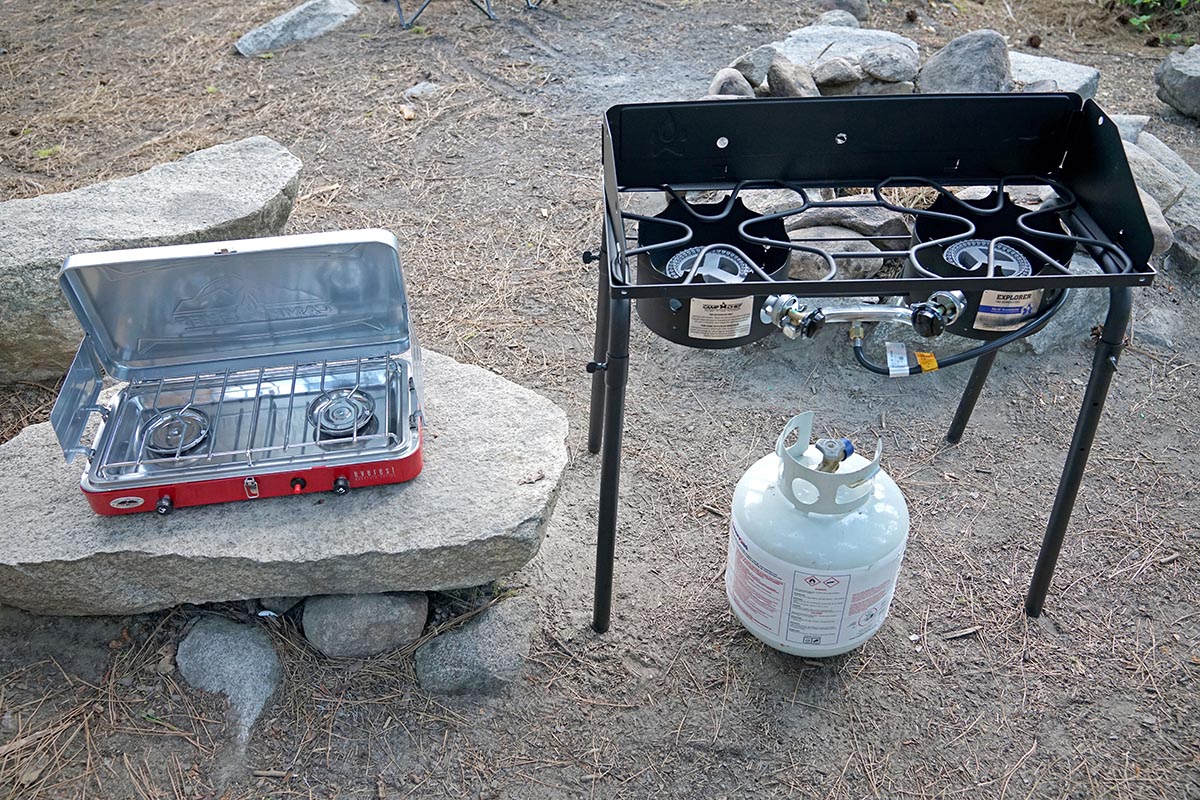
By and large, campers prefer tabletop stoves. Their small(er) footprint and lighter weight are easy to pack up and fit into a car, and on a high-quality build like the Camp Chef Everest 2X, the drop in performance is fairly minimal. You do need something to set it on, however. If you’re heading deep into the unknown or are basecamping in a remote location but still desire a gourmet meal, you’ll probably need to bring a camping table not only for the stove but also for any prep work.
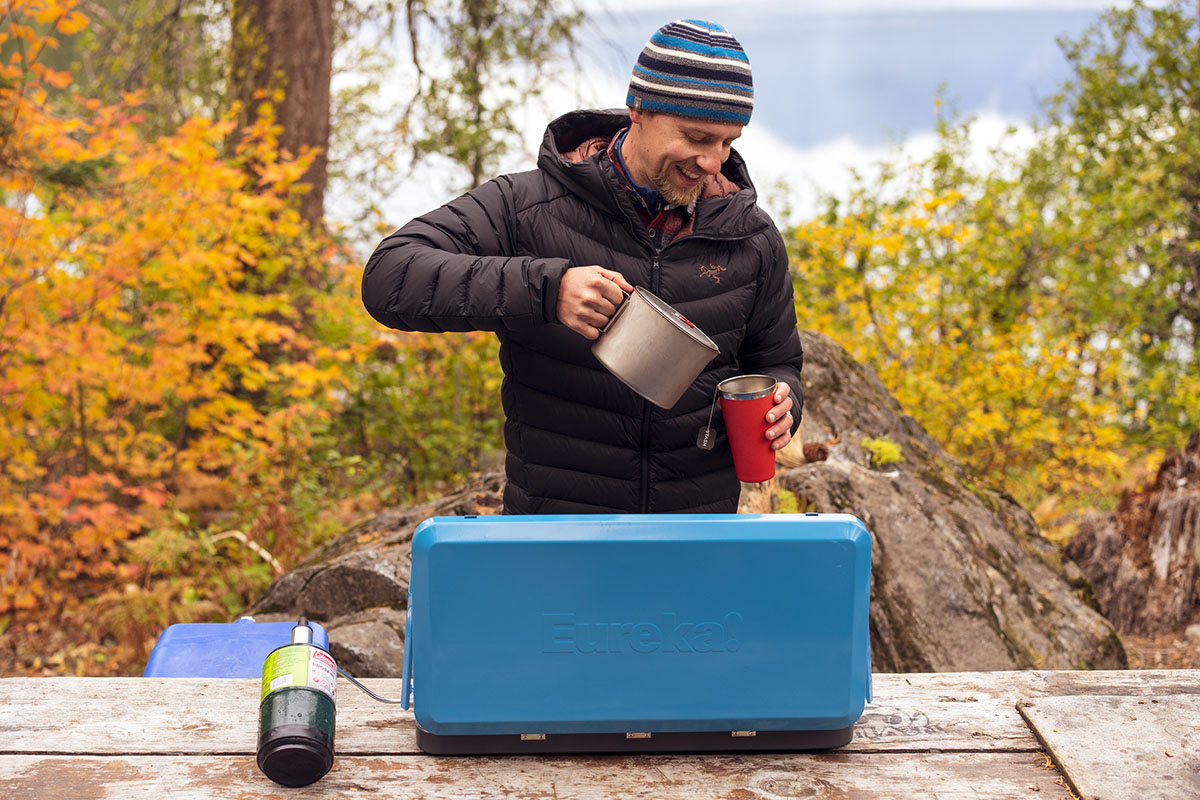
It’s no coincidence most of the big-time sellers come with two burners—they’re all the vast majority of us will ever need. As with cooking at home, two burners going at the same time will get most meals over the finish line in a timely manner. Additionally, it’s often the better choice over the more limited single-burner stove, although some of those designs do have appeal for crossing over into backpacking. And for large gatherings, there are three-burner options like the Stansport 3-Burner Stove. In many cases, with a large group, it’s not a bad idea to put the onus on someone else to bring along a second stove, as packing a three-burner can be burdensome from a weight and bulk perspective. Three-burner models also generally offer less width per burner than a standard two-burner so as not to become exceptionally wide.
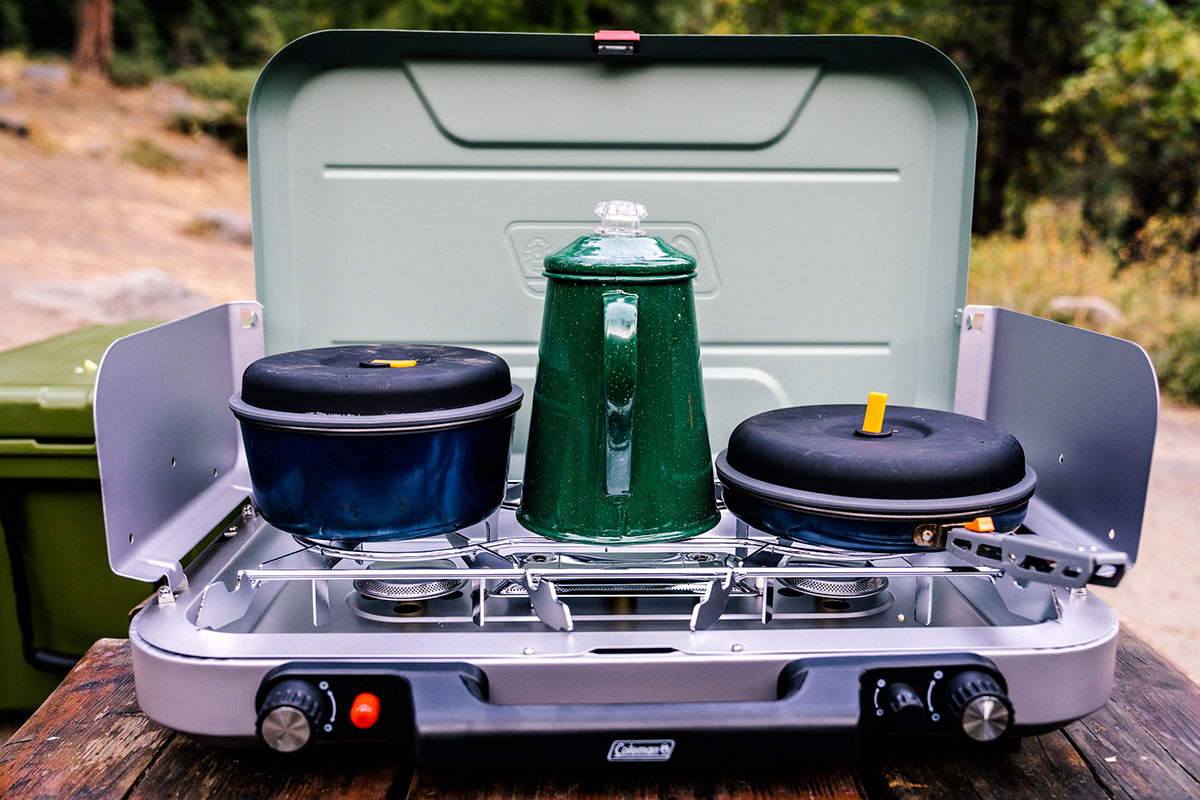
An alternate option for larger groups is to choose a stove that can be daisy-chained to another system. For example, the Jetboil Genesis Basecamp System can be linked to other Jetboil models, all while connected to a single propane bottle. This allows you to increase cooking space without having to lug around a heavy freestanding stove. And on outings where you don’t need the added burner(s), you can simply leave one of the stoves behind.
.jpg)
BTU, or British Thermal Unit, is a measurement of heat output. More specifically, it’s the amount of energy needed to heat 1 pound of water by 1 degree Fahrenheit. In the context of camping, it serves as a standard for determining the performance potential of a gas stove. While BTUs shouldn’t be looked at as the sole indicator of power—cooking surface area can impact the flame’s actual intensity—it’s a great way of comparing stoves overall. If you’re used to a 10,000-BTU burner and are eyeing a 20,000-BTU-per-burner model like the Camp Chef Everest 2X, we can guarantee that the difference will be noticeable.
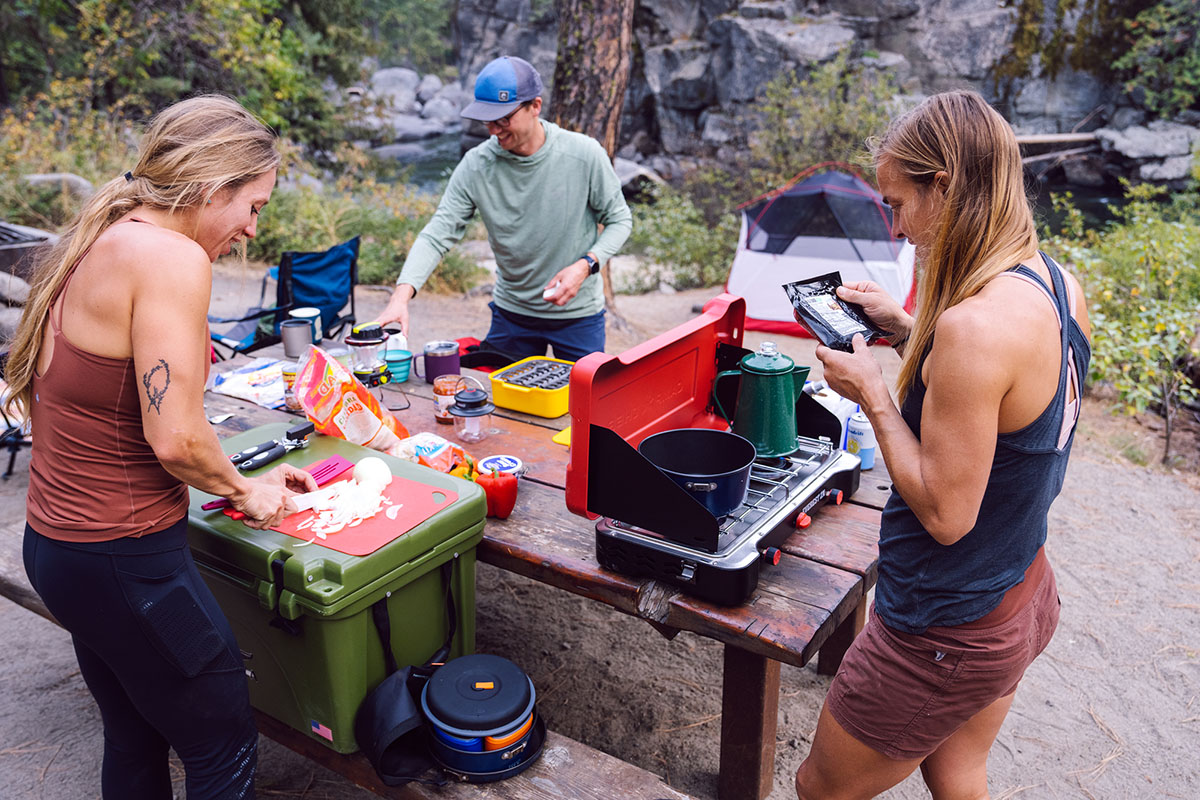
The boost in power comes with various benefits. For one, a stronger flame will allow you to cook more food faster—you can trim minutes off your time when boiling a large pot of water. As such, for large groups, a more powerful flame (20,000 BTUs and up) is recommended. With that extra output comes greater fuel consumption, which can become an issue if a powerful stove is fueled by a small 16-ounce propane bottle. You’ll definitely want to bring along a few backup canisters if you’ll be out for more than an overnight trip, and we’ve found that two quality 10,000-BTU burners are ample for most uses.
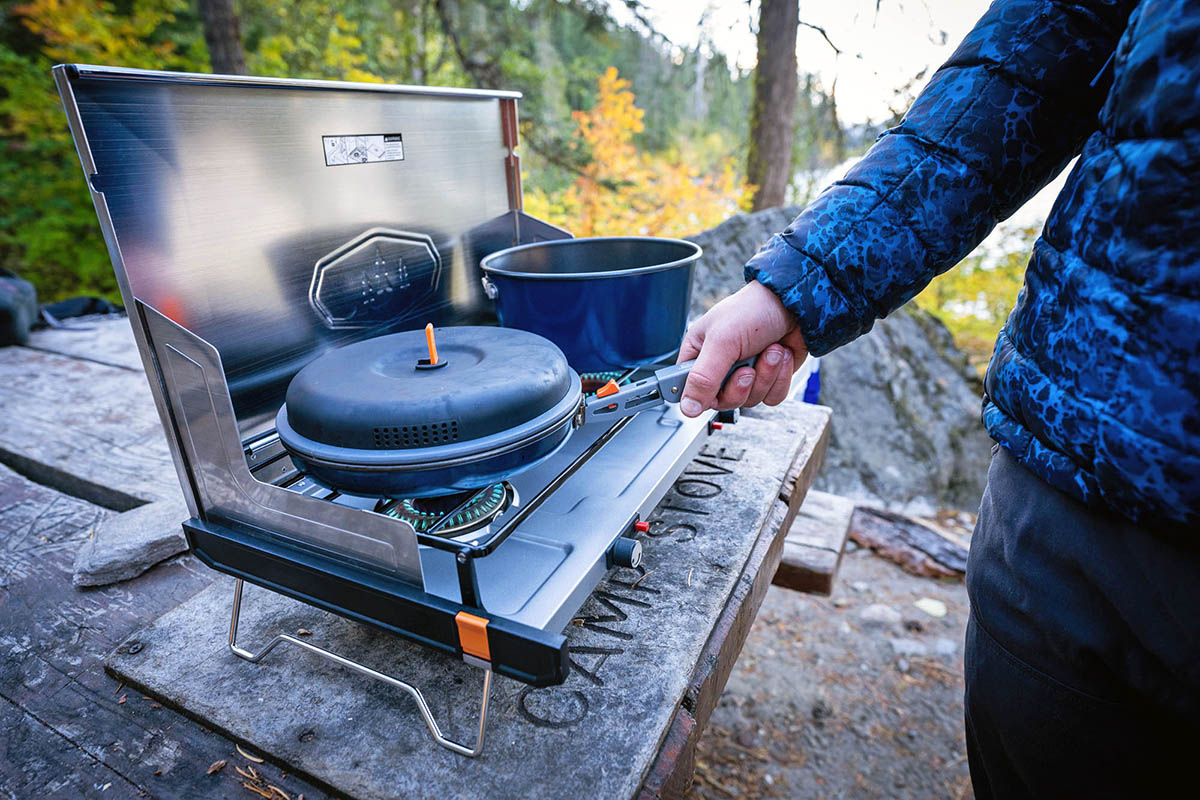
The vast majority of camping stoves run on propane: The fuel performs well in a range of temperatures, and not by any coincidence, the little green bottles are readily available at just about any outdoors or big box retail store. For the sake of space, and if you won’t be setting up camp for an extended period of time, the 16-ounce bottles should do. However, we highly recommend bringing a few of them, no matter the length of your stay. At high heat with some of the more powerful stoves, you can burn through most of a bottle in a single day. For max cooking convenience, the classic 4.6-gallon tank (also referred to as a 20-lb. tank) is a tried-and-true choice. They’re easy to fit into the back of a pickup bed, refillable in just about every town, and will last you many, many meals. Note: Most tabletop stoves come only with an attachment for the 16-ounce bottle, but an adapter and hose are often available to fit the larger-capacity tanks.
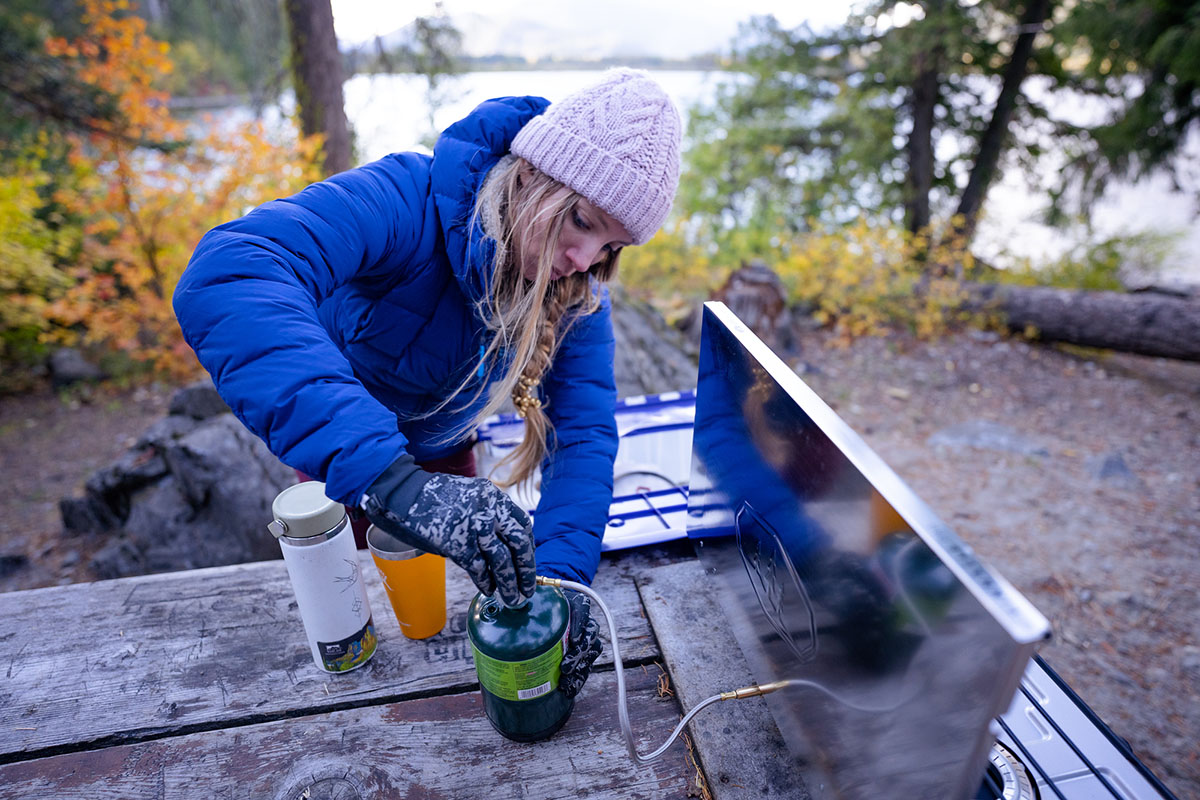
Propane does start to see its performance diminish once the temperatures dip below freezing. Butane, used for the Coleman Classic 1-Burner, does even worse and isn’t as readily available as propane, but the canisters are lighter and more compact (this is more of a consideration for backpackers). That said, if you’ll be doing a lot of four-season camping, liquid fuel is the most reliable choice and can come in the form of white gas, unleaded gasoline, jet fuel, kerosene, or diesel. White gas is one of the best choices for backpacking and basecamping in extreme conditions, but there aren’t a whole lot of options in a full-size camping stove style. If you’re a hardcore adventurer, consider a stove like the Coleman Guide Series Dual Fuel (not listed above and often hard to find), which can run on either white gas or unleaded gasoline. Liquid-fuel stoves tend to cost more than propane models and don’t offer any performance benefits in mild conditions, so for most folks, propane remains the best option.
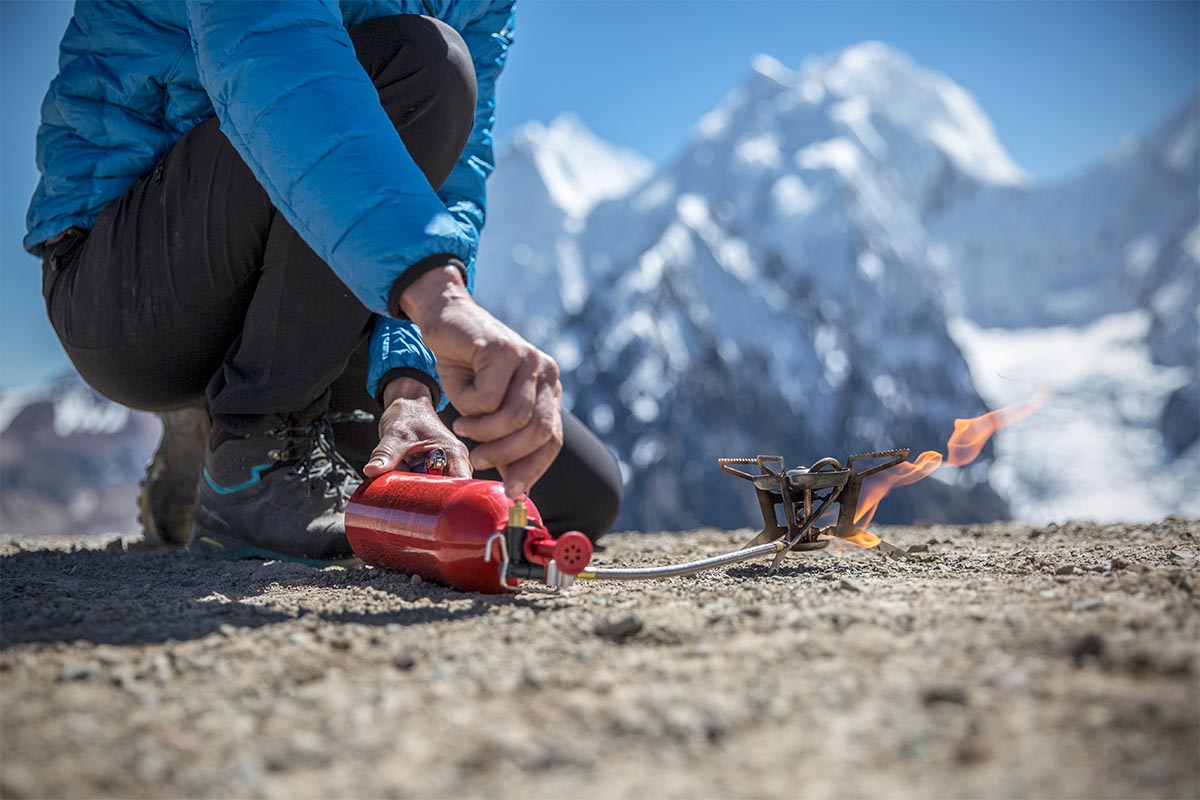
Propane and other gases aside, there are a couple alternative fuel types that may work depending on your needs and expected conditions. Wood-burning stoves like the Solo Stove Campfire have gained popularity in recent years, and the allure is clear: There’s no need to buy or bring along fuel canisters—you simply collect twigs and sticks at camp and burn them to cook your food. However, these systems have more limited flame and heat control compared to other models, are restricted during fire bans, and rely on a resource that might not be readily available depending on the terrain and weather. Finally, there are solar-powered designs like GoSun’s Sport Solar Cooker, which again can’t compete with the convenience or dependability of traditional models but allows for fuel-free cooking in the right conditions.
While a blazing 20,000 BTU burner is great for a spaghetti feast, for items that require a little more finesse, you’ll want to make sure your stove has effective simmer control. This requires fuel regulation that doesn’t fluctuate and a flame that remains strong even at low heat. Good simmer performance isn’t something typically found on a spec sheet, but a high-end model will typically perform better in these conditions. Moreover, having a good windscreen will help keep the flame lit if you’re running the heat on low. The Camp Chef Everest 2X has excellent simmer control, while budget stoves like the Coleman Cascade Classic struggle. Spending up will increase your chances of mastering a complex backcountry meal.
.jpg)
The weather can be variable even in the fairest of months, but the show must go on. And that includes cooking up a decent hot meal. The flame on any stove is sensitive to shifting and blowing wind, and it’ll be important to find a somewhat protected space no matter the stove you choose. To help, there are windshields on many models that cover three sides of the stove. This type of protection is a must-have, but it still won’t protect you from really strong gusts. In general, we've found that the smaller the footprint, the better the wind resistance, but large freestanding stoves can be set up just about anywhere, so hopefully, you can find a decent windbreak.
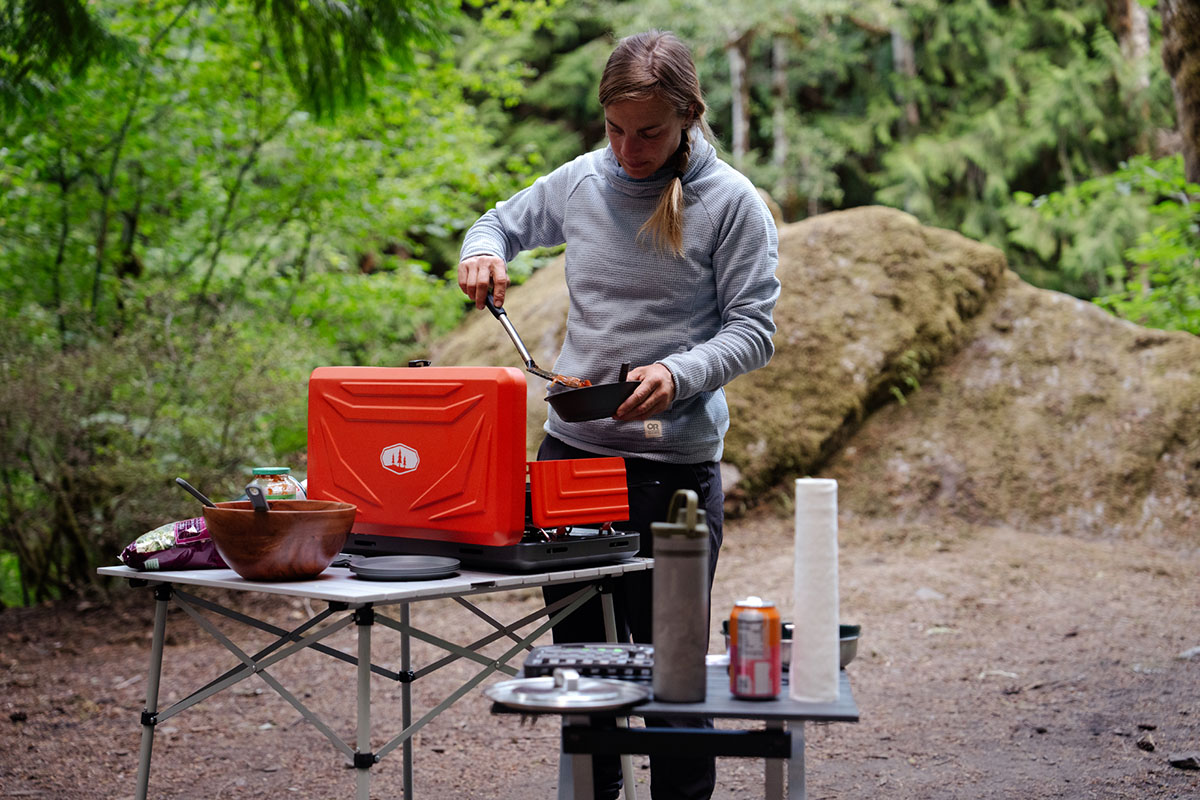
The width of camping stoves varies significantly and can have an impact on what types of cookware you can use. For example, we like the Camp Chef Everest 2X because it features a wide 25-inch cooking surface that can accommodate medium to large pots side by side. Smaller units, like the Coleman Triton, can only fit two 10-inch pans. If you regularly use larger pots or pans, or even a wok, it’s worth digging into this spec closely before making a purchase (most manufacturers and retailers will publish the dimensions and we have them listed above for each pick). Alternatively, if you're picking out your first stove, make sure the cookware you buy will fit on your unit’s cook surface.
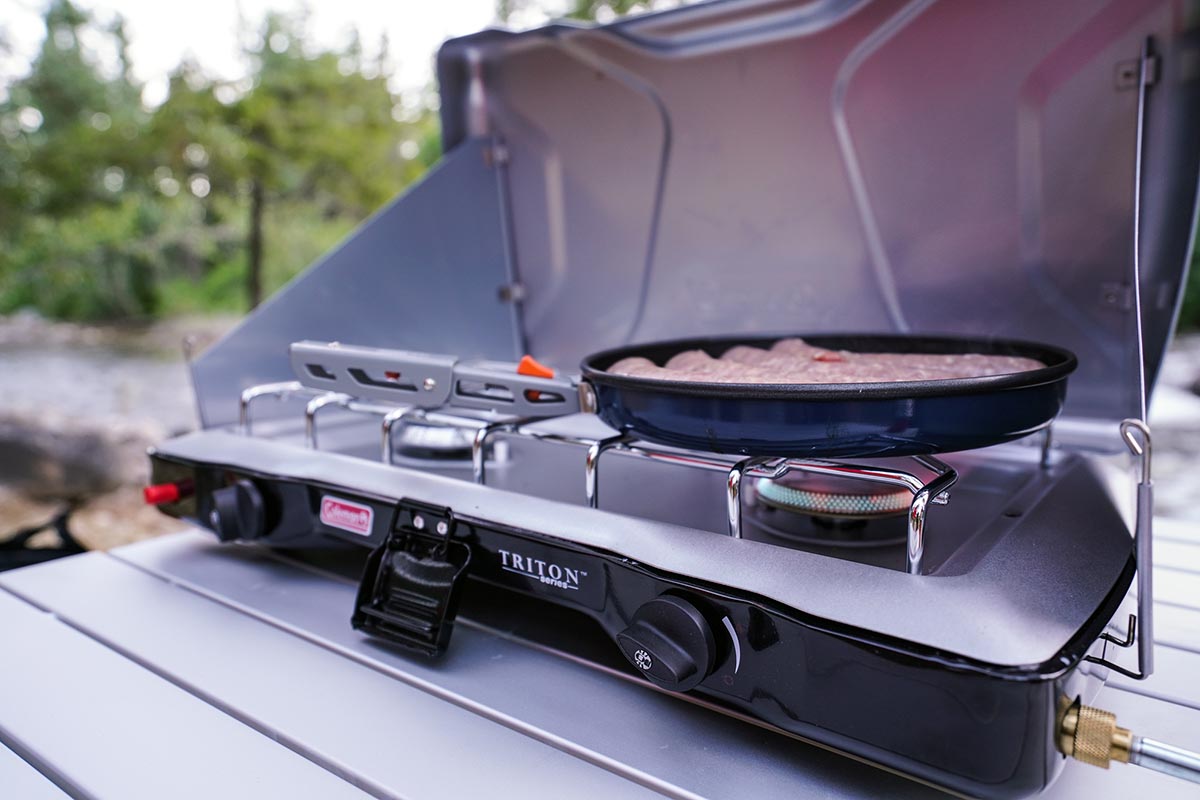
Piezoelectricity is a pressure-based (read: matchless) form of ignition that is popular in camping stove applications. Rather than the sometimes-harried process of turning on the fuel and quickly lighting a match or clicking a lighter, this form of push-button auto ignition keeps your hands safe from any large bursts of flame. We prefer this type of ignition for the added convenience and ease of use, but it does come at an extra cost. Upgrading to the piezo-equipped Coleman Triton+, for example, will cost you $20 more than the base model. It’s also true that these igniters are not perfect and often fail over time (sometimes surprisingly quickly after purchase), so always bring along a set of extra matches or a lighter just in case.
.jpg)
The most common form of stove is the traditional two-burner with a single, large cooking grate. But should you want a grill and stove combo, say, for cooking sausage and eggs, a hybrid option may be is pretty appealing. Keep in mind that, on some models, the grill portion may take up about 2/3 of the cooktop, which can swallow valuable space for fitting a large skillet or pot. Coleman’s Cascade 3-in-1 solves that problem with both burners having removable grill/griddle accessories. Similarly, stoves like the Camp Chef Explorer allow you to swap out accessory tops, including a barbecue box or pizza oven. Griddles are separate attachments that fit over the top of the burners, and just like at home, they’re great for cooking up items like pancakes or grilled cheese.
As with most camping equipment, weight and packed size aren’t necessarily specs to be overly concerned about. Compared with backpacking gear, it’s all heavy and large, but you still need to store and transport the stuff. In general, we look for an effective balance of performance and weight, which is why we rank the Camp Chef Everest 2X so highly. It clocks in at a very manageable 12 pounds, folds down easily to fit into a duffel bag, and provides some of the most impressive output for a tabletop model. On the flip side, the wood-burning Solo Stove Campfire is the lightest design on our list at 2 pounds 3.2 ounces, but it lacks the versatility and cooking capabilities of traditional two-burner designs.
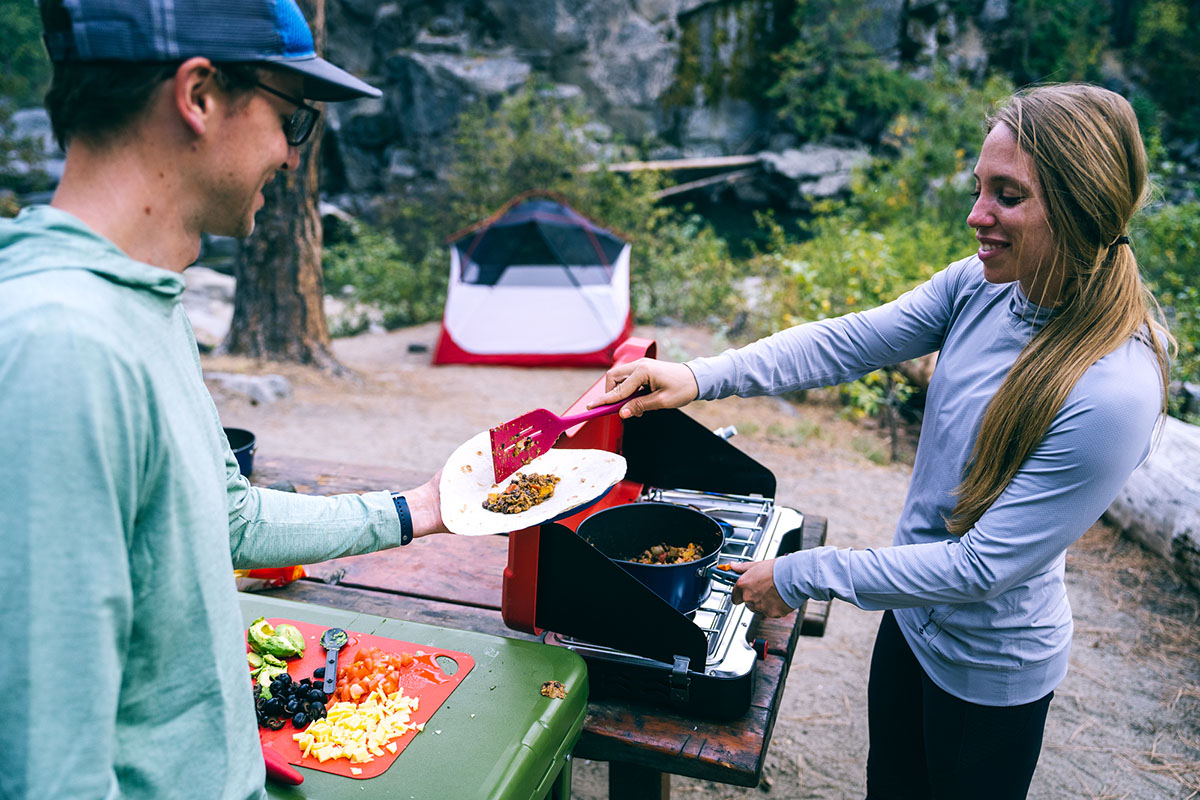
Depending on your needs, packed size may or may not play a big role in your buying decision. If it does, a model like the GSI Pinnacle Pro is a great option at only 1.4 inches tall when packed (for reference, the aforementioned Everest 2X is 5.6 in., and a freestanding unit like the Camp Chef Explorer is 14 in.). This makes it easy to slide into the crevice of a vehicle or back corner of a gear closet. Taking it a step further, we also like Jetboil’s Genesis Basecamp System, which includes a stove and cookware, manages to weigh less than 10 pounds, and folds down to nest into the included pot and carry bag. Again, these considerations don’t matter to some campers, but they can make a difference for those limited on space.
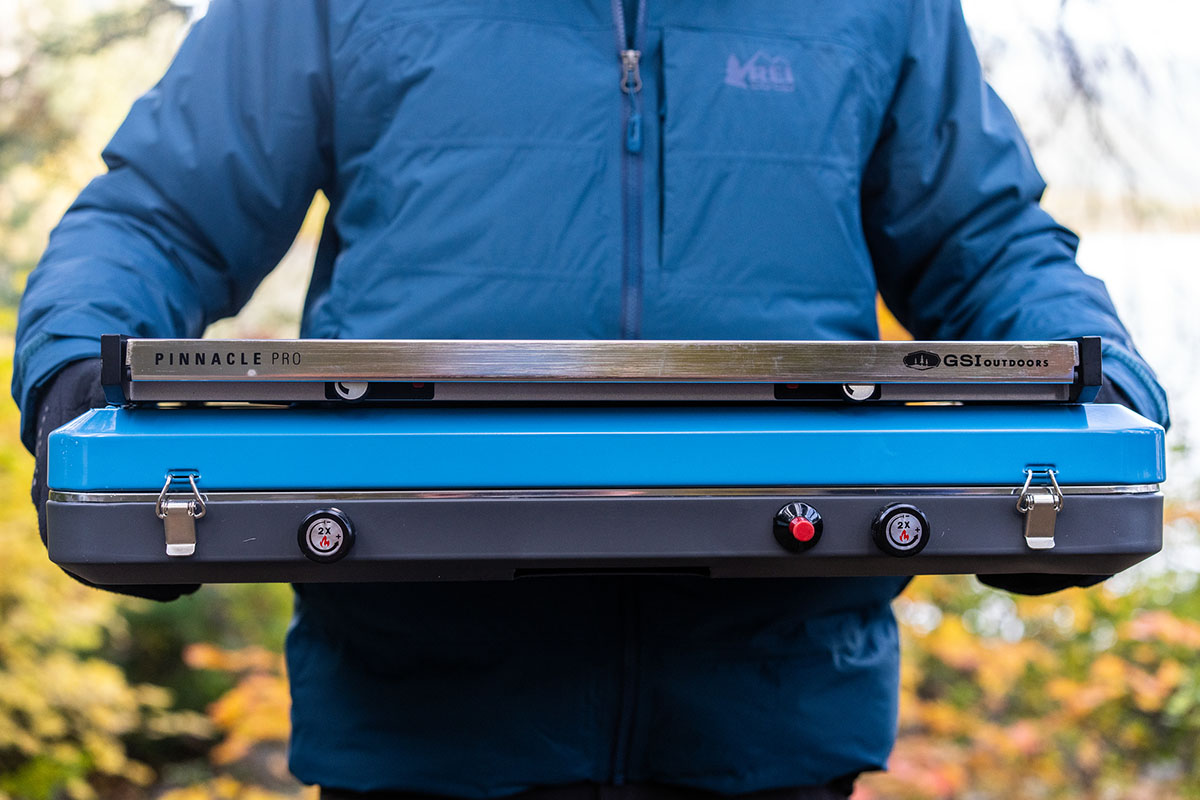
For those weighing the decision (literally) between camping and backpacking stoves, there are some important trade-offs to consider. In addition to a lighter weight and smaller packed size, backpacking models only feature a single burner that can hold a pot or pan, which limits cooking space and the types of meals that you can cook (most backpackers stick to simple foods like dehydrated or one-pot meals). In addition, backpacking stoves are much flimsier, less stable, and don’t simmer as well as camping models. If you won’t be traveling far from your vehicle, a camping stove will offer a substantial increase in performance and the added heft and bulk likely won’t matter much. However, if you trek deep into the backcountry regularly, the weight savings are well worth the sacrifice in cooking ability.
Back to Our Top Camping Stove Picks Back to Our Camping Stove Comparison Table